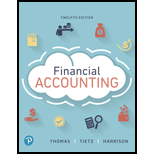
Financial Accounting (12th Edition) (What's New in Accounting)
12th Edition
ISBN: 9780134725987
Author: C. William Thomas, Wendy M. Tietz, Walter T. Harrison Jr.
Publisher: PEARSON
expand_more
expand_more
format_list_bulleted
Textbook Question
Chapter E, Problem 4QC
Crandall's investment is in less than 2% of Mobil's stock, which Crandall expects to hold for three years and then sell. What type of investment is this?
- a. Debt
- b. Equity with significant influence
- c. Equity with insignificant influence
- d. Consolidation
Expert Solution & Answer
Want to see the full answer?
Check out a sample textbook solution
Students have asked these similar questions
Question 4
Waterfront Inc. wishes to borrow on a short-term basis without
reducing its current ratio below 1.25. At present its current assets
and current liabilities are $1,600 and $1,000 respectively. How much
can Waterfront Inc. borrow?
(5 marks)
discus extensivery source of bussines finances
requaments
not less than 4 pages
font size 12
spacing 1.5
roman times
references must be less thhan 5
Calculate stricklers cash conversion cycle?
Chapter E Solutions
Financial Accounting (12th Edition) (What's New in Accounting)
Ch. E - Prob. 1QCCh. E - Rolling Hills Productions held investments in...Ch. E - Prob. 3QCCh. E - Crandall's investment is in less than 2% of...Ch. E - Dumois Corporation purchased 1,500 shares of...Ch. E - Prob. 6QCCh. E - Use the Dumois Corporation data in question 5....Ch. E - Prob. 8QCCh. E - Prob. 9QCCh. E - Prob. 10QC
Ch. E - Prob. E.1SCh. E - (Learning Objective 2: Account for investments in...Ch. E - Prob. E.3SCh. E - Prob. E.4SCh. E - Prob. E.5SCh. E - Prob. E.6SCh. E - Prob. E.7SCh. E - Prob. E.8SCh. E - Prob. E.9SCh. E - Prob. E.10SCh. E - (Learning Objective 5: Record a held-to-maturity...Ch. E - Prob. E.12SCh. E - (Learning Objective 5: Calculate and record...Ch. E - Prob. E.14SCh. E - Prob. E.15SCh. E - Prob. E.16SCh. E - Prob. E.17AECh. E - (Learning Objective 2: Record transactions for...Ch. E - (Learning Objective 2: Analyze and report...Ch. E - Prob. E.20AECh. E - Prob. E.21AECh. E - Prob. E.22AECh. E - Prob. E.23AECh. E - Prob. E.24BECh. E - Prob. E.25BECh. E - (Learning Objective 2: Analyze and report...Ch. E - (Learning Objective 3: Account for transactions...Ch. E - Prob. E.28BECh. E - Prob. E.29BECh. E - Prob. E.30BECh. E - Prob. E.31QCh. E - Prob. E.32QCh. E - Prob. E.33QCh. E - Prob. E.34QCh. E - Prob. E.35QCh. E - Dividends received on an equity-method investment...Ch. E - Prob. E.37QCh. E - Prob. E.38QCh. E - Prob. E.39APCh. E - (Learning Objectives 2, 3: Analyze and report...Ch. E - (Learning Objectives 2, 3: Analyze and report...Ch. E - Prob. E.42APCh. E - Prob. E.43BPCh. E - LO 2, 3 (Learning Objectives 2, 3: Analyze and...Ch. E - Prob. E.45BPCh. E - Prob. E.46BPCh. E - Prob. E.47DC
Additional Business Textbook Solutions
Find more solutions based on key concepts
Questions For Review
12-4. How is the concept of the value package useful in marketing to consumers and industr...
Business Essentials (12th Edition) (What's New in Intro to Business)
Explain how to derive a total expenditures (TE) curve.
Macroeconomics
Define costvolumeprofit analysis.
Horngren's Cost Accounting: A Managerial Emphasis (16th Edition)
••• 4.13 As you can see in the following table, demand for heart transplant surgery at Washington General Hospi...
Operations Management
CHAPTER CASE
S&S Air’s Mortgage
Mark Sexton and Todd Story, the owners of S&S Air, Inc., were impressed by the ...
Essentials of Corporate Finance (Mcgraw-hill/Irwin Series in Finance, Insurance, and Real Estate)
Net Operating Loss, Carryforward, Tax Rate Change. Hamilton Container Company reported the following income (lo...
Intermediate Accounting (2nd Edition)
Knowledge Booster
Learn more about
Need a deep-dive on the concept behind this application? Look no further. Learn more about this topic, accounting and related others by exploring similar questions and additional content below.Similar questions
arrow_back_ios
SEE MORE QUESTIONS
arrow_forward_ios
Recommended textbooks for you

 Cornerstones of Cost Management (Cornerstones Ser...AccountingISBN:9781305970663Author:Don R. Hansen, Maryanne M. MowenPublisher:Cengage Learning
Cornerstones of Cost Management (Cornerstones Ser...AccountingISBN:9781305970663Author:Don R. Hansen, Maryanne M. MowenPublisher:Cengage Learning Intermediate Financial Management (MindTap Course...FinanceISBN:9781337395083Author:Eugene F. Brigham, Phillip R. DavesPublisher:Cengage Learning
Intermediate Financial Management (MindTap Course...FinanceISBN:9781337395083Author:Eugene F. Brigham, Phillip R. DavesPublisher:Cengage Learning EBK CONTEMPORARY FINANCIAL MANAGEMENTFinanceISBN:9781337514835Author:MOYERPublisher:CENGAGE LEARNING - CONSIGNMENT
EBK CONTEMPORARY FINANCIAL MANAGEMENTFinanceISBN:9781337514835Author:MOYERPublisher:CENGAGE LEARNING - CONSIGNMENT



Cornerstones of Cost Management (Cornerstones Ser...
Accounting
ISBN:9781305970663
Author:Don R. Hansen, Maryanne M. Mowen
Publisher:Cengage Learning

Intermediate Financial Management (MindTap Course...
Finance
ISBN:9781337395083
Author:Eugene F. Brigham, Phillip R. Daves
Publisher:Cengage Learning

EBK CONTEMPORARY FINANCIAL MANAGEMENT
Finance
ISBN:9781337514835
Author:MOYER
Publisher:CENGAGE LEARNING - CONSIGNMENT
What Are Stock Buybacks and Why Are They Controversial?; Author: TD Ameritrade;https://www.youtube.com/watch?v=2O4bmcliaog;License: Standard youtube license